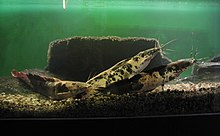
Catfish are a diverse group of ray-finned fish. Named for their prominent barbels, which resemble a cat's whiskers, catfish range in size and behavior from the three largest species alive, the Mekong giant catfish from Southeast Asia, the wels catfish of Eurasia, and the piraíba of South America, to detritivores, and even to a tiny parasitic species commonly called the candiru, Vandellia cirrhosa. Neither the armour-plated types nor the naked types have scales. Despite their name, not all catfish have prominent barbels or "whiskers". Members of the Siluriformes order are defined by features of the skull and swimbladder. Catfish are of considerable commercial importance; many of the larger species are farmed or fished for food. Many of the smaller species, particularly the genus Corydoras, are important in the aquarium hobby. Many catfish are nocturnal, but others are crepuscular or diurnal.

Clarias is a genus of catfishes of the family Clariidae, the airbreathing catfishes. The name is derived from the Greek chlaros, which means lively, in reference to the ability of the fish to live for a long time out of water.

Amphibious fish are fish that are able to leave water for extended periods of time. About 11 distantly related genera of fish are considered amphibious. This suggests that many fish genera independently evolved amphibious traits, a process known as convergent evolution. These fish use a range of methods for land movement, such as lateral undulation, tripod-like walking, and jumping. Many of these methods of locomotion incorporate multiple combinations of pectoral-, pelvic-, and tail-fin movement.

The eel catfish is an airbreathing catfish found in the muddy swamps of the tropics of Central Africa. It grows up to 32.7 cm in total length, and is notable for its ability to propel itself out of the water to catch prey.

Clarias nieuhofii, the slender walking catfish, is a species of clariid catfish. It has a wide distribution in Southeast Asia including southern Vietnam, Cambodia, Thailand, Malay Peninsula, parts of the Greater Sunda Islands, and the Philippines.

Uegitglanis zammaranoi is the only species of catfish in the genus Uegitglanis of the family Clariidae. It is endemic to Somalia, where it only occurs in caves near the Jubba and the Shebelle Rivers. This species grows to about 10.1 cm (4.0 in) in total length.
Dolichallabes microphthalmus is the only species of airbreathing catfish in the genus Dolichallabes.

Clarias gariepinus or African sharptooth catfish is a species of catfish of the family Clariidae, the airbreathing catfishes.
Anguilliformity is a morphological pattern in fishes, named for and typified by the eels. Anguilliform fish have a long, slender body, and travel by anguilliform motion. The caudal fin is often emphasized, with the other fins reduced, absent, or fused with the caudal fin. Anguilliformity has evolved independently in many groups, including among others:

Platyclarias machadoi is the only species in the genus Platyclarias of catfishes of the family Clariidae. It originates from the upper Cuango River in Angola. It reaches up to 20.1 centimetres (7.9 in) TL. P. machadoi is easily identified among the clariids due to its extremely flattened head relative to other clariids.
Platyallabes tihoni is the only species in the genus Platyallabes of catfishes of the family Clariidae. This species is found in the Malebo Pool. P. tihoni has a body plan that is intermediate to the generalized, fusiform (torpedo-shaped) type such as Clarias species and the anguilliform (eel-shaped) type such as Gymnallabes. This species is known to grow up to 52.8 centimetres (20.8 in) TL.
Heterobranchus boulengeri is a species of airbreathing catfish found in the Democratic Republic of the Congo, Zambia and Zimbabwe. It is found in Lake Mweru, the Lukonzolwa River and the upper Congo River.

Clarias kapuasensis is a species of clariid catfish from Borneo. It has been described from the upper part of the River Kapuas

Clarias peudoleiacanthus is a species of clariid catfish from Borneo. It has been described from the southern lower parts of the River Kapuas (Western Kalimantan and coastal areas near the Barito River in southern Kalimantan, Indonesia

Clarias intermedius is a species of clariid catfish from Indonesian Borneo. It has been described from Central Kalimantan, Indonesia, between the Sampit and Barito rivers.
Clarias pseudonieuhofii is a species of clariid catfish from Borneo. It has been currently described from the upper basin of the Kapuas River in West Kalimantan, in a geographic area bordering Sentarum Lake. It has been differed from C. nieuhofii by comparing the holotypes and paratypes from specimens of C. nieuhofii from Sumatra.
Clarias anfractus is a species of clariid catfish from Borneo. It is known from the Segama and Kalabakan drainages in Sabah, Northeastern Borneo.
Clarias planiceps is a species of clariid catfish from Borneo. It is known from tributaries all over Sarawak, and possibly up to Kapuas Hulu Regency.
Clarias insolitus is a catfish within the genus Clarias, found in the upper drainage of the Barito River, in Kalimantan, Indonesian Borneo.
Clarias lamottei is a supposed species of clariid from the Ivory Coast. It has been doubted to be a natural intergeneric hybrid by Teugels, between Clarias gariepinus and Heterobranchus longifilis, through comparisons with three other Clarias and one other Heterobranchus species. Teugels suspects the striking morphological similarities between C. lamottei and extant aquaculture hybrids between the African sharptooth catfish and vundu, of which both have overlapping distribution. Despite this, IUCN evaluations have been made through the observation of the holotype habitat around the Nzi river.












